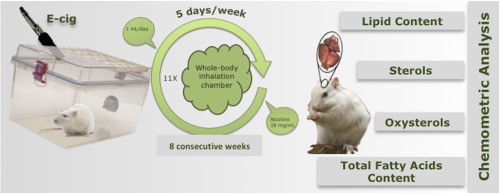Biochimie ( IF 3.9 ) Pub Date : 2018-08-02 , DOI: 10.1016/j.biochi.2018.07.027 Vladimiro Cardenia , Fabio Vivarelli , Silvia Cirillo , Moreno Paolini , Donatella Canistro , Maria Teresa Rodriguez-Estrada

|
The electronic cigarettes (e-cigarettes, e-cigs) have become the most sought-after alternative to the traditional cigarettes, partly due to the widespread perception of safety. However, the high temperature reached by e-cig solutions can generate toxic compounds, some of which are listed as known human carcinogens. To evaluate the impact of e-cig aerosol on rat brain lipid profile, twenty male Sprague Dawley rats were exposed to 11 cycles/day (E-cig group), to consume 1 mL/day of e-liquid, for 5 days/week up to 8 weeks. Ten rats were sacrificed after 4 weeks (4w) and ten at the end of treatment (8w). The composition of total fatty acids, sterols and oxysterols of the lipid fraction of rat brains, was analyzed. The results of the E-cig group were compared with those of the control group (not exposed). After 8 weeks, the saturated fatty acids significantly raised up to 7.35 mg/g tissue, whereas polyunsaturated fatty acids decreased reaching 3.17 mg/g. The e-cig vaping increased both palmitic (3.43 mg/g) and stearic acids (3.82 mg/g), while a significant decrement of arachidonic (1.32 mg/g) and docosahexaenoic acids (1.00 mg/g) was found. Atherogenic (0.5) and thrombogenic (1.12) indices also increased in 8w treated animals. The e-cig aerosol significantly impacted the cholesterol homeostasis, since the latter at 8w (21.57 mg/g) was significantly lower than control (24.56 mg/g); moreover, a significant increase of 7-dehydrocholesterol (1.87 mg/g) was also denoted in e-cig group. The e-cig aerosol also reduced the oxysterol formation (19.55 μg/g) after 4 weeks of exposure, except for triol and 5α,6α-epoxycholesterol (α-EC). The principal component analysis (PCA) separated all E-cig from control groups, evidencing that oxysterols (except triol and 24(S)-hydroxycholesterol (24(S)-HC)) were inversely correlated to 7-DHC and TI. The present research revealed that e-cigs aerosol affected the lipid and cholesterol homeostasis in rat brain, which could contribute to the new occurrence of some neurodegenerative diseases.
中文翻译:

电子烟气雾剂对大鼠脑脂质分布的影响
电子烟(电子烟,电子烟)已成为传统香烟的最抢手替代品,部分原因是人们对安全性的普遍认识。但是,电子烟溶液达到的高温会产生有毒化合物,其中一些被列为已知的人类致癌物。为了评估e-cig气雾剂对大鼠脑脂质分布的影响,将20只雄性Sprague Dawley大鼠暴露于11个周期/天(E-cig组),每天消耗1 mL e-液体,每周5天长达8周。在4周(4w)后处死10只大鼠,在治疗结束时(8w)处死10只。分析了大鼠脑脂质部分的总脂肪酸,固醇和氧固醇的组成。将E-cig组的结果与对照组(未暴露)的结果进行比较。8周后,饱和脂肪酸显着升高至7.35 mg / g组织,而多不饱和脂肪酸降低至3.17 mg / g。电子烟雾化增加了棕榈酸(3.43 mg / g)和硬脂酸(3.82 mg / g),而花生四烯酸(1.32 mg / g)和二十二碳六烯酸(1.00 mg / g)明显降低。在8w处理的动物中,致动脉粥样硬化指数(0.5)和血栓形成指数(1.12)也增加。e-cig气雾剂显着影响胆固醇的体内稳态,因为后者在8w(21.57 mg / g)时显着低于对照(24.56 mg / g)。此外,e-cig组的7-脱氢胆固醇(1.87 mg / g)也显着增加。除三醇和5α,6α-环氧胆固醇(α-EC)外,电子烟气雾剂在暴露4周后还减少了氧固醇的形成(19.55μg/ g)。主成分分析(PCA)将所有E-cig从对照组中分离出来,表明氧固醇(三醇和24(S)-羟基胆固醇(24(S)-HC)除外)与7-DHC和TI呈负相关。目前的研究表明,e-cigs气溶胶会影响大鼠脑内脂质和胆固醇的体内稳态,这可能有助于某些神经退行性疾病的新发生。



























 京公网安备 11010802027423号
京公网安备 11010802027423号